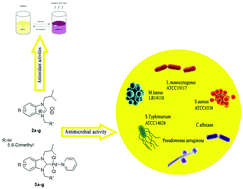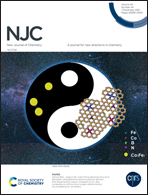N-Heterocyclic carbene-palladium-PEPPSI complexes and their catalytic activity in the direct C–H bond activation of heteroarene derivatives with aryl bromides: synthesis, and antimicrobial and antioxidant activities†
Abstract
In this study, a series of unsymmetrical 1,3-disubstituted benzimidazolium chlorides 2a–g with two nitrogen atoms substituted by different alkyl groups were synthesized in high yields as N-heterocyclic carbene (NHC) precursors. These benzimidazolium salts were then converted into the corresponding Pd–NHC complexes of the PEPPSI family (PEPPSI = pyridine-enhanced precatalyst preparation, stabilization, and initiation) 3a–g. The structures of all compounds were characterized by 1H nuclear magnetic resonance (NMR) spectroscopy, 13C NMR spectroscopy, infrared spectroscopy, and elemental analysis, which support the proposed structures. The structure of the 3c complex was determined by X-ray crystallography. More detailed structural characterization of the 3c complex was performed through single-crystal X-ray diffraction, which supports the proposed structures. The Pd–NHC–PEPPSI complexes were used as catalysts in the direct C5-arylation of 2-acetyl furan, 2-acetylthiophene, and 2n-propylthiazole with different aryl bromides. These complexes exhibited moderate-to-high catalytic activities and selectively at the C5 position. Furthermore, the Pd–NHC–PEPPSI complexes were evaluated for their potential antibacterial properties against a panel of bacterial strains, such as Micrococcus luteus, Listeria monocytogenes, Salmonella typhimurium, Staphylococcus aureus, Candida albicans, and Pseudomonas aeruginosa. The Pd–NHC–PEPPSI complex 3f showed better activity than ampicillin against Micrococcus luteus, with an MIC of 0.035 mg mL−1. In addition, the antioxidant activities of the complexes 3d and 3f showed considerable free radical scavenging activity.



 Please wait while we load your content...
Please wait while we load your content...